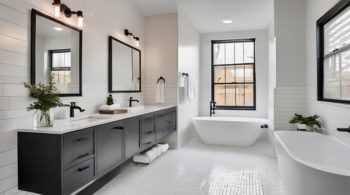If you’re ready to create a smart mirror using Home Assistant, you’ll start by gathering key parts: a Raspberry Pi 4B, a two-way mirror, and a compatible display. Setting up the software involves installing Home Assistant on the Pi and customizing the dashboard to show weather, news, and smart device controls. Adding features like motion sensors or face recognition can make your mirror truly responsive. But before you plunge into it, it’s important to understand how these components work together for seamless integration.
Overview of Smart Mirror Components
Building a smart mirror starts with understanding its key components and how they work together. The core smart mirror features include a 40-inch Samsung TV behind a two-way mirror, creating a sleek user interface you can interact with.
Touchscreen control comes from an infrared frame, letting you manage smart home devices like lights and vacuums directly on the mirror. A Raspberry Pi 4B runs Home Assistant in a Docker container, organizing your devices and displaying info.
Face recognition, powered by a Pi camera and OpenCV, personalizes data by recognizing users, while multiple dashboards show weather, news, and calendar updates.
Hardware Requirements and Setup
To get started, you’ll need essential hardware like a Raspberry Pi 4B, an SD card with at least 4GB, and a monitor to place behind your two-way mirror.
Setting up your devices properly includes configuring sensors for motion detection and installing a camera for face recognition. These steps guarantee your smart mirror runs smoothly and responds accurately to your presence.
Essential Hardware Components
A reliable setup starts with selecting the right hardware components that fit your smart mirror project’s needs.
Focus on integrating these essentials within the mirror frame, paying close attention to sensor placement for ideal performance.
Here’s what you’ll need:
- A Raspberry Pi 4B, 4GB SD card, and a 40-inch Samsung TV behind a two-way mirror.
- A Pi camera for face recognition and an infrared frame for touch capabilities.
- Sensors like PIR or RCWL-0516 for motion detection, plus LED strips and a power supply.
Organize wiring carefully to keep components accessible and secure.
Initial Device Configuration
Several key steps will get your smart mirror’s hardware ready for operation, starting with setting up the Raspberry Pi 4B.
Begin the initial device configuration by flashing balenaOS onto a minimum 4GB SD card and inserting it into the Pi. Connect the Pi to your home network to enable remote access.
Next, assemble the hardware—attach the two-way mirror to the 40-inch monitor and install the infrared frame for touchscreen functionality.
Don’t forget to add a PIR motion sensor for auto on/off.
Finally, proceed with the software installation to run Home Assistant in a Docker container, completing your setup.
Installing Home Assistant on Raspberry Pi
Getting Home Assistant up and running on your Raspberry Pi involves flashing the Raspberry Pi OS onto an SD card that has at least 4GB of storage.
For a smooth Raspberry Pi setup and Home Assistant installation, follow these steps:
- Use balenaOS if you have a Raspberry Pi 4 for easier management and Kiosk mode.
- Boot your Pi, then configure a static IP in your router’s DHCP settings to keep access stable.
- Adjust Home Assistant’s settings to trust your network, allowing seamless login from your smart mirror.
This guarantees your smart mirror runs reliably and efficiently.
Configuring the Smart Mirror Dashboard
While setting up your smart mirror, configuring the dashboard correctly is essential for both usability and appearance.
Start by creating a dedicated Home Assistant user to enhance dashboard security. Use the Kiosk Mode add-on to remove headers and menus, giving your mirror a clean look.
Organize content with grids or stacks for layout optimization, ensuring all elements are functional and visually balanced.
Add custom cards like `custom:dvb-card` by placing JavaScript files in Home Assistant’s `www` folder, then use “Add card” to integrate them.
Finally, enable auto-reload to keep your dashboard’s information fresh and responsive.
Integrating Motion Sensors for Auto On/Off
After setting up your smart mirror dashboard, adding motion sensors can greatly improve how your mirror responds to your presence.
For an effective motion detection setup, start by choosing either a PIR or RCWL-0516 sensor. Follow sensor wiring tips found in the monitor_on_off directory to connect the sensor correctly to your Raspberry Pi.
Then, set execution permissions for the control scripts and configure them to autostart on boot. This guarantees your mirror powers on when you approach and turns off after inactivity, saving energy.
Remember these steps:
- Correct sensor wiring
- Script permission setup
- Autostart configuration
Customizing the Dashboard With Lovelace Cards
One of the most effective ways to personalize your smart mirror dashboard is by using Lovelace cards, which let you display weather updates, calendar events, and smart home statuses in a clean, organized format.
Start by adding cards through the dashboard’s “Add card” option, including custom JavaScript cards placed in the `www` directory. Use Markdown cards for consistent headings and styled text.
Employ dashboard layout strategies like horizontal or vertical stacks to keep everything neat and accessible. For Lovelace customization tips, enable auto reload to refresh data every 20 minutes, ensuring your display stays current and reliable.
Enhancing Functionality With Face Recognition
You’ll start by setting up face recognition using a Pi camera and OpenCV to capture and identify users.
Once the system recognizes a face, it can display personalized data like reminders and schedules tailored to that person.
This step adds a new level of interaction, making your smart mirror truly responsive to who’s in front of it.
Face Recognition Setup
Setting up face recognition for your smart mirror begins with installing OpenCV on your Raspberry Pi, which allows the device to accurately identify and differentiate between faces.
Position the Pi camera for clear face detection, ensuring good lighting to reduce errors. Then, configure Home Assistant to use automation triggers based on recognized faces.
To get started:
- Install OpenCV and test camera placement.
- Set lighting conditions for reliable recognition.
- Link recognized faces to automation triggers in Home Assistant.
Regularly update your face database to maintain accuracy as appearances change.
Personalized Data Display
How can your smart mirror become truly personal? By using face recognition to display personalized data, it identifies users through a Pi camera and OpenCV.
When it recognizes you, the mirror pulls up your unique user profile, showing relevant info like calendar events, weather, or smart home controls. This means no more manual logins—each family member sees what matters to them.
Machine learning improves accuracy over time, adapting to changes in appearance or lighting.
Be mindful of data privacy by securing user profiles and limiting access to sensitive info, ensuring your smart mirror is both personal and safe.
Frequently Asked Questions
Can I Use a Different Operating System Besides Home Assistant OS?
Yes, you can use alternative systems besides Home Assistant OS, but you’ll need to guarantee software compatibility with Home Assistant’s components. Some users prefer Docker or generic Linux distros to customize their smart mirror setup more flexibly.
How Do I Troubleshoot Wi-Fi Connectivity Issues on the Mirror?
Check your network configuration to guarantee correct Wi-Fi settings. Reduce Wi-Fi interference by moving your mirror away from other electronics. Restart your router and mirror, then verify signal strength to troubleshoot Wi-Fi connectivity issues effectively.
What Are the Best Power-Saving Settings for the Raspberry Pi?
You should reduce power consumption by disabling HDMI output when not in use and lowering CPU frequency. Enable energy efficiency settings like turning off unused peripherals and using a lightweight OS to keep your Raspberry Pi running efficiently.
Can I Add Music Playback Controls to the Smart Mirror Dashboard?
Yes, you can add music integration to your smart mirror dashboard by embedding a playback interface. This lets you control music directly, making it easy to play, pause, or skip tracks right from your mirror’s display.
How Do I Securely Back up My Home Assistant Configuration?
You should use configuration management tools and set up automated backup strategies in Home Assistant. Regularly export your config, store backups securely offsite, and encrypt sensitive data to keep your setup safe from loss or tampering.
Christina Pulluck helped bring Nebula Electronics from a a science and tech decision forum to a full-fledged news site by creating a new design and branding. She continues to assist in keeping the site responsive and well organized for the readers. As a contributor to Nebula Electronics, Christina mainly covers mobile news and gadgets.







